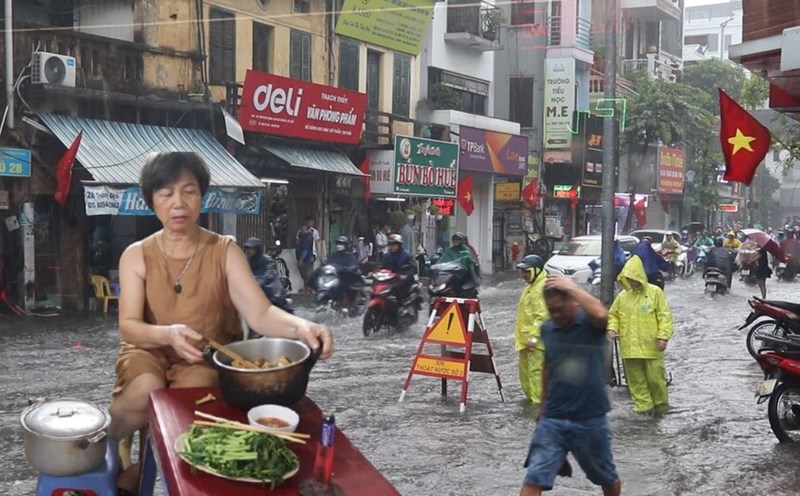I first met Thao A Pe in 2020, during a business trip to the old Sa Pa town. It was a foggy afternoon covering the entrance to Y Linh Ho 2 village - a place whose name sounded like a fairy tale. There, in the middle of a simple wooden roof, there is a free classroom opened by Pe for children in the village.
No podium, no white envelope, only the covers for teaching English lettering, a few old books and the gentle voice of the Pe on the top of the mountain.
When he learned that I was a reporter for Lao Dong Newspaper, Pe smiled brightly: I often collect old newspapers at a water shop in the district. For a long time, there was a Tet newspaper and the whole family sat watching it all night. Now that I have a newspaper from you, I really appreciate it".
I cant forget the tearful eyes of Mrs. Vang Thi May Pes mother when receiving the newspapers I brought with me. She does not read Kinh language fluently, but every time there is a new newspaper, she asks her son to read it for her. "The newspaper has many beautiful photos and beautiful words, like gifts sent by people in the lowlands" - Ms. May said.
Since then, I have regularly sent Lao Dong Newspaper to the village every Spring. These are not just printed paper, but joy, a message of love between journalists and cultural preservers, between the lowlands and the upper regions.
Pe's students have never seen an imprint, and do not know about recording machines, but they love stories that tell their lives. There was a little card user: "I want to be a journalist, travel as much as you, write about my village to the whole country". I asked again: "How to write well like in Lao Dong Newspaper?" Those questions, innocent but sincere, made me feel that the profession of journalism, which seemed too familiar, suddenly became sacred once again.
Thao A Pe considers Lao Dong Newspaper as a friend. For every good article, he prints it and applies it to the classroom walls. Every story about workers overcoming difficulties, about village teachers or extraordinary workers becomes a vivid lesson for children. "Your newspaper helps me sow dreams for the children. Some say they want to be translators in the future, others say they want to tell stories like Mr. Pe, like the journalist - Pe said.
This year is the 5th year I have sent a report to Pe. The New Year's newspapers no longer have the scent of new paper, but still keep their affection intact. Carefully wrap the newspaper in a nylon bag, so that the student can read it gradually. There are cold winter evenings, the whole class sit around the fire, listening to Lao Dong Newspaper through the voice of a teacher - a class that will probably follow them until they are grown up.
In Nam Tong - a resettlement area located in Coc Lau commune, Lao Cai province, it was once struggling to cope with storm No. 3 in 2024. After the natural disaster, new houses were built, and people were supported to stabilize their lives. And in the midst of that journey, there were Lao Dong Newspapers quietly present as a warm word of encouragement.
Here, the Newspapers for Tet are carefully read, carefully pressed with plastic, and even solemnly hung on wooden walls as a cultural symbol. People consider newspapers as "professional reporters" about life in many places, both to learn and to remember the moment of transformation after loss.
Mr. Sung A Kenh - one of the households moving to Nam Tong after the storm, remembers clearly the moment he received Lao Dong Xuan Nham Thin 2025. "It was cold that day, my daughter was sick, I took her to get medicine and was informed. I held the newspaper but my hands trembled not because of the wind, but because of emotion. The newspaper has photos of workers making roads, there is a story about a teacher in the highlands. I feel like I am empowered.
As for Mr. Ly Seo Khanh, he kept the entire Tet newspaper in a wooden box. He said that every year he tries to find enough numbers, each category, and then divide them to households to read gradually. "Everyone here now hopes to report back. The newspaper not only has news, but also has beautiful poems, stories, and paintings. Some people even cut paintings in newspapers and stuck them on the walls like Tet paintings" - Mr. Khanh said.
Mr. Ly Seo Tho - Head of Nam Tong resettlement area - shared: "After the people moved to a new place, Lao Dong Newspaper was one of the first spiritual gifts we received. The H'Mong people here not only read to know the news, but also see the newspaper as a way to connect with the life of the lowlands - a place that always cares about our highland people".
The special thing is that children in Nam Tong are also excited every time there is a newspaper. They are not old enough to understand the articles in depth, but are fascinated by illustrative paintings, portrait photos of characters, and vivid colors. Under the new roof, children born after the storm are growing up with the newspaper by turning every page, asking every question and cherishing dreams of a brighter future.
Not everyone knows that for printed newspapers to reach Nam Tong, they have to go through many winding roads of dirt and rocks. But for the people here, it is the path to knowledge and faith. They cherish each newspaper like the city cherishes a precious book - because the newspaper is a symbol of connection, sharing and lasting hope after natural disasters.











